
No, we do not have
a political agenda. We are a non-profit science
organization!
This research gets funding from nobody!
|
Greenhouse GasesAl Gore in his famous artistic movie about Global Warming presented his biggest piece of evidence: The correlation between CO2 and temperature in the last 800 thousand years. "Who can still deny this?!"What we are led to believe is the following (image on the right): CO2 changes cause temperature (T) changes, the so-called greenhouse effect. Let's analyze this claim |
 model
|
Here is that famous 'Al-Gore' plot of CO2 and
temperature in the last 800 thousand years (here now also
includes CH4, methane, another strong greenhouse gas):
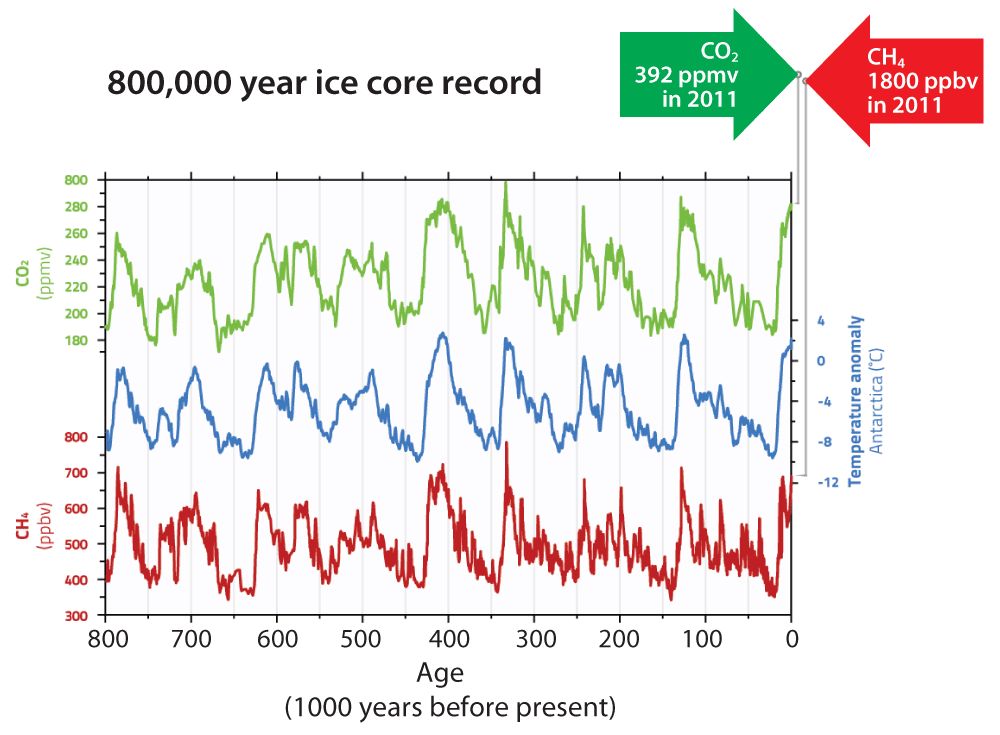
Taken from Ref. [1]
Some comments:
1) First of all, proving a mere correlation does not show which one is causing which one. The classical problem of cause-and-effect. If we look in detail in the data, we see that CO2 is lagging behind temperature. That makes temperature changes the cause and not the effect of CO2 changes!
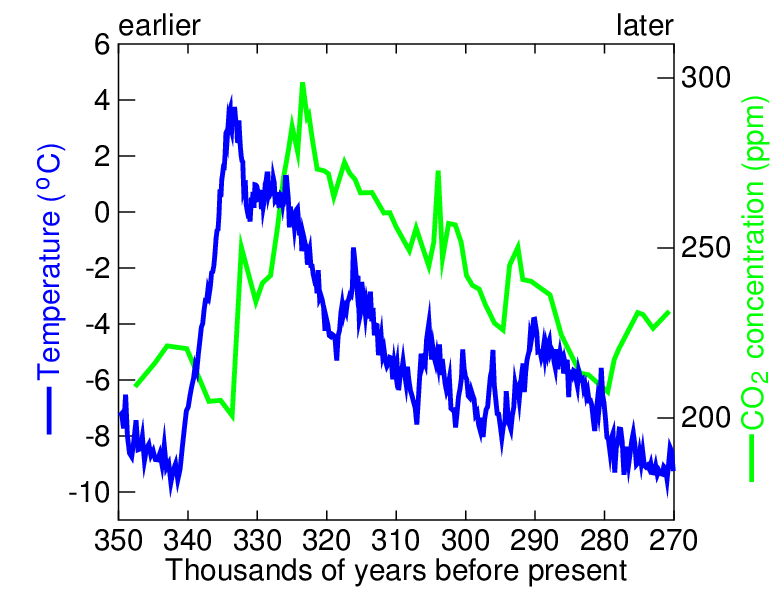
Image above is a zoom in to
some detail of above plot. CO2 lags behind T.
Data form PANGEA project, image from Ref. [6]
The data have later been reanalyzed and, upon closer scrutiny, the lag between temperature (T) and CO2 is about a thousand years. Below is an excerpt of a paper of Indermühle, et al. from 2000 [7]:
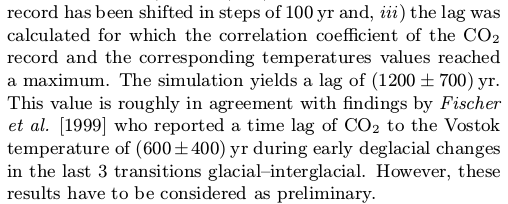
2) The same correlations are not seen on longer or shorter time scales. On a short time scale there is no correlation. Above figure: 180-280 ppm CO2 swing is associated to a -12-+2 oC temperature swing, so we have a sensitivity of about 1 degree per 10 ppm. The current level of 392 ppm would increase temperature further +10 degrees. The greenhouse effect is a rather instantaneous effect (as fast as heating up and cooling during the day-and-night). At best a tiny (<< 1 degree) is observed. The blue line does not follow the green line.
In a figure:

The statistical correlation is poor-to-absent (apart from two peaks at 1850 and 1940, there is nothing). Moreover, the sensitivity is different in this figure: a CO2 swing of 160 ppm is translated into a temperature swing of only 0.6 degrees. Or, in other words, 1 degree per 300 ppm (30 times less).
Note also that the two points of correlation (1850 and 1940) again show that CO2 is lagging behind. But, anyway, on this time scale no correlation between T and CO2 is expected because out-gassing is a process that occurs on the time scale of centuries to millenniums. Only in the time scale of thousands of years do we expect a correlation.
The only data that are regularly presented to you are the Mauna Loa data (green line). Why do you think that is so? In any case no correlation between (Mauna Loa) CO2 and T is observed.
On a much longer time scale the following is observed (Note that the Al-Gore plot shown in the beginning is less than a pixel of this image):

Image taken from Ref. [2].
Note the 7000 ppm CO2 concentrations (20 times more than now, 1900%). That while temperatures were the same. On the long time scale there is no correlation between CO2 and temperature.
Similarly:
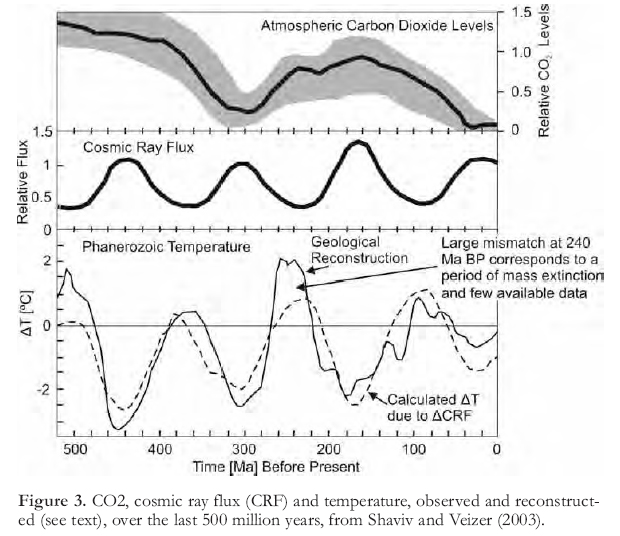
We see that there exists a very plausible alternative instead of CO2 as a driving force on a long time scale, namely cosmic rays driving the climate. Moreover, in this case it is clear which one is cause and which one is effect. (It would be very difficult to explain how the temperature on Earth would have influence on the cosmic ray intensity).
Cosmic rays change the cloud cover of our planet by ionizing air particles which function as water-condensation nuclei (think of a cloud chamber) and hence change the temperature.
Note that politicians are trying to cover up this story:
The chief of the world's leading physics lab at CERN in Geneva has prohibited scientists from drawing conclusions from a major experiment. The CLOUD ("Cosmics Leaving Outdoor Droplets") experiment examines the role that energetic particles from deep space play in cloud formation. CLOUD uses CERN's proton synchrotron to examine nucleation.
CERN Director General Rolf-Dieter Heuer told Welt Online that the scientists should refrain from drawing conclusions from the latest experiment. Heuer says, "That would go immediately into the highly political arena of the climate change debate. One has to make clear that cosmic radiation is only one of many parameters." Citation from Ref. [5].
Yes, please, dear scientists, do not draw conclusions or even discuss things. leave that up to the politicians. They are much better equipped for that.
If these CERN employees had discovered that Global Warming is consistent with their data, would they also have been shut up? What do you think?
3) It is as good as impossible to explain how both CO2 and CH4 are varying in the same way as temperature. They cannot be both climate forcing and yet be varying simultaneously (what is correlating them?!). It is, however, very easy to explain that both are the result of temperature. If temperature changes, both CH4 and CO2 in the atmosphere because of out-gassing of the oceans and the land.
Take a look again at the image with the 800,000-year ice-core record in the beginning of this page and then the diagrams below (T is temperature, CO2 and CH4 are concentrations of these gasses in the atmosphere):
4) There has been more CO2 in the atmosphere very recently:
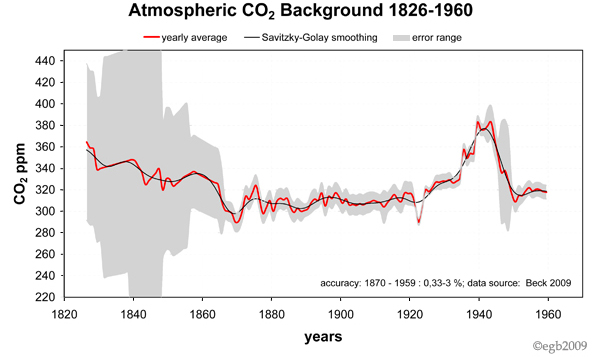
From Beck [3]
Note that in 2010 the CO2 concentration is about 390 ppm, about the same as in 1941. This had no effect on the climate.
These data are removed from standard presentations to program the people into believing the catastrophic climate models.
5) It has been suggested by some IPCC members and followers that sulfates (aerosols injected into the atmosphere by -- yet again -- human activity, namely industry) are causing a cooling of the planet, thus offsetting the warming trend of the CO2 greenhouse effect. According to them, this might explain the dip in temperature in the middle of the 20th century and why the temperature is not rising as fast as expected (see the failure of IPCC predictions).
However, this reasoning is impossible to maintain.
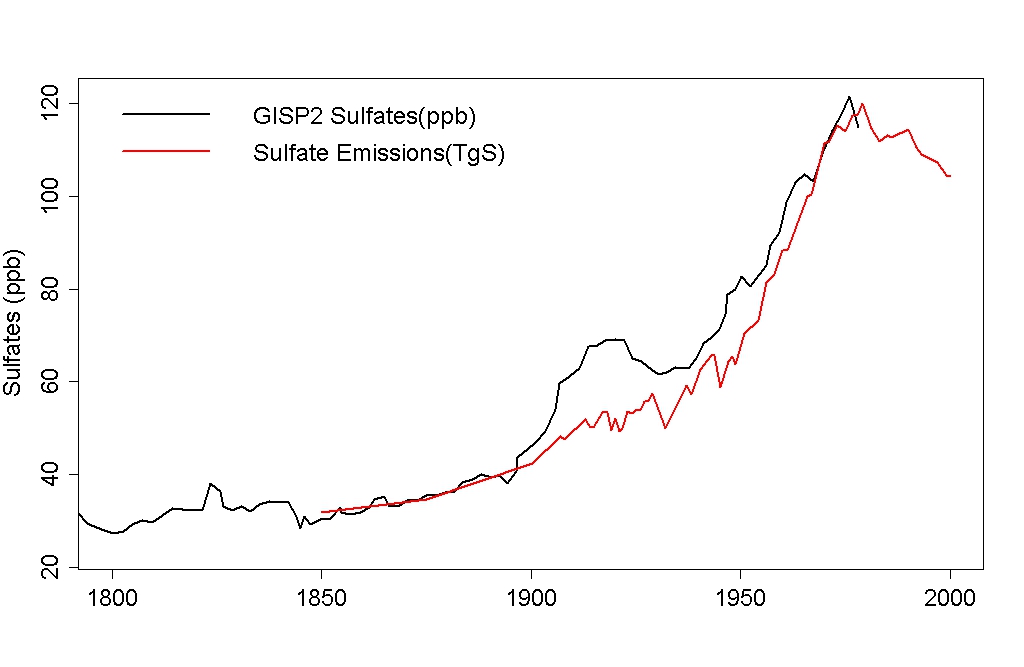
Image from Ref. [4]
The above picture shows the aerosol injection and concentration in the atmosphere, supposedly responsible for cooling and offsetting the CO2 green-house effect. This picture shows that it is difficult to attribute the cooling since 1950 and warming since 1970 to a reduction in sulfur emissions removing the offset of green house gases.
Aerosols have not disappeared from the atmosphere. Of course, it might theoretically be so that there was an ultrafine balance between aerosol cooling effects and CO2 warming effects, the balance that was removed the moment aerosols leveled off and CO2 continued their rise. And, I am sure, it is possible to simulate this, adjusting the forcing factors of the two until the model coincides with the data. That does not take anything off the problem that this fine balance is rather dubious to start with. Moreover, with CO2 still being on the rise and aerosols declining, the temperature should then have sky-rocketed in the beginning of this century. Which it didn't. It is more likely that either CO2 or aerosols are more important climate forcing and until one is significantly more/less abundant than it is now, that one will win. In other words, either CO2 causes significant warming or aerosols cause significant cooling, but not both!
On the other hand, if you believe in this aerosol argument and believe we are doomed by a heating planet, you have the solution in your hands: increase pollution of industry. Subsidize aerosol emissions to compensate the CO2 emissions!
[1] http://www.igbp.net/publications/policybriefsforrio20summit/policybriefsforrio20summit/interconnectedrisksandsolutionsforaplanetunderpressure.5.20d892f132f30b443080001954.html
[2] Geocraft.com
[3] http://www.biomind.de/realCO2/
[4] http://tamino.wordpress.com/2010/08/23/antrhopogenic-global-cooling/
[5] http://www.theregister.co.uk/2011/07/18/cern_cosmic_ray_gag/
[6] Stallinga, De mythe van klimaatsveranderingen, Lulu.
[7] A. Indermühle, et al., Geophysical Letters, vol. 27, p. 735-738 (2000).
For more information, contact me at The University of The Algarve,

Taken from Ref. [1]
Some comments:
1) First of all, proving a mere correlation does not show which one is causing which one. The classical problem of cause-and-effect. If we look in detail in the data, we see that CO2 is lagging behind temperature. That makes temperature changes the cause and not the effect of CO2 changes!

Data form PANGEA project, image from Ref. [6]
The data have later been reanalyzed and, upon closer scrutiny, the lag between temperature (T) and CO2 is about a thousand years. Below is an excerpt of a paper of Indermühle, et al. from 2000 [7]:

| So, now it has been
established that CO2 is actually lagging behind
temperature. This closes the subject on Anthropogenic
Global Warming. There is no need to discuss further
until this point is resolved. Apart from the fact that the data tell us this, it is also very easy to understand. See image on right. T causes CO2. This is a very plausible explanation of the data. It is called Henry's Law, the ratio between the concentrations of a certain gas in the ocean and the air above it are constant depending on temperature. When oceans and land masses are warming up they are out-gassing. When the oceans heat up, they liberate gas, just like boiling water for tea liberates gasses contained within the water. In this model, it does not make sense to think that increasing the amount of gasses above our tea will increase its temperature. Likewise, increasing CO2 in the atmosphere will not significantly increase the temperature of the oceans or the air. The out-gassing of oceans is a process in the time scale of 100-1000 years because of the large body of water and the long time it takes to heat up. |
 |
2) The same correlations are not seen on longer or shorter time scales. On a short time scale there is no correlation. Above figure: 180-280 ppm CO2 swing is associated to a -12-+2 oC temperature swing, so we have a sensitivity of about 1 degree per 10 ppm. The current level of 392 ppm would increase temperature further +10 degrees. The greenhouse effect is a rather instantaneous effect (as fast as heating up and cooling during the day-and-night). At best a tiny (<< 1 degree) is observed. The blue line does not follow the green line.
In a figure:

The statistical correlation is poor-to-absent (apart from two peaks at 1850 and 1940, there is nothing). Moreover, the sensitivity is different in this figure: a CO2 swing of 160 ppm is translated into a temperature swing of only 0.6 degrees. Or, in other words, 1 degree per 300 ppm (30 times less).
Note also that the two points of correlation (1850 and 1940) again show that CO2 is lagging behind. But, anyway, on this time scale no correlation between T and CO2 is expected because out-gassing is a process that occurs on the time scale of centuries to millenniums. Only in the time scale of thousands of years do we expect a correlation.
The only data that are regularly presented to you are the Mauna Loa data (green line). Why do you think that is so? In any case no correlation between (Mauna Loa) CO2 and T is observed.
On a much longer time scale the following is observed (Note that the Al-Gore plot shown in the beginning is less than a pixel of this image):

Note the 7000 ppm CO2 concentrations (20 times more than now, 1900%). That while temperatures were the same. On the long time scale there is no correlation between CO2 and temperature.
Similarly:

We see that there exists a very plausible alternative instead of CO2 as a driving force on a long time scale, namely cosmic rays driving the climate. Moreover, in this case it is clear which one is cause and which one is effect. (It would be very difficult to explain how the temperature on Earth would have influence on the cosmic ray intensity).
Cosmic rays change the cloud cover of our planet by ionizing air particles which function as water-condensation nuclei (think of a cloud chamber) and hence change the temperature.
Note that politicians are trying to cover up this story:
The chief of the world's leading physics lab at CERN in Geneva has prohibited scientists from drawing conclusions from a major experiment. The CLOUD ("Cosmics Leaving Outdoor Droplets") experiment examines the role that energetic particles from deep space play in cloud formation. CLOUD uses CERN's proton synchrotron to examine nucleation.
CERN Director General Rolf-Dieter Heuer told Welt Online that the scientists should refrain from drawing conclusions from the latest experiment. Heuer says, "That would go immediately into the highly political arena of the climate change debate. One has to make clear that cosmic radiation is only one of many parameters." Citation from Ref. [5].
Yes, please, dear scientists, do not draw conclusions or even discuss things. leave that up to the politicians. They are much better equipped for that.
If these CERN employees had discovered that Global Warming is consistent with their data, would they also have been shut up? What do you think?
3) It is as good as impossible to explain how both CO2 and CH4 are varying in the same way as temperature. They cannot be both climate forcing and yet be varying simultaneously (what is correlating them?!). It is, however, very easy to explain that both are the result of temperature. If temperature changes, both CH4 and CO2 in the atmosphere because of out-gassing of the oceans and the land.
Take a look again at the image with the 800,000-year ice-core record in the beginning of this page and then the diagrams below (T is temperature, CO2 and CH4 are concentrations of these gasses in the atmosphere):
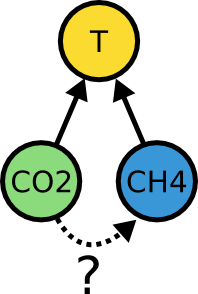 |
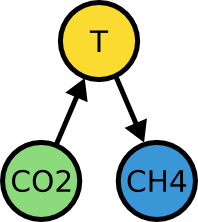 |
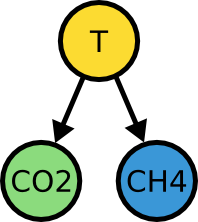 |
| Both CO2 and CH4 climate
forcing. Enigma: How is the statistically-proven
correlation between CO2 and CH4 accomplished? |
Possible (but dubious)
explanation: secondary-effect CO2 causes T and T
causes CH4 through out-gassing (or possibly other way
around) |
More likely explanation
(once we have admitted that down-arrow correlations
are permissible): T
causes both CO2 and CH4 |
4) There has been more CO2 in the atmosphere very recently:

Note that in 2010 the CO2 concentration is about 390 ppm, about the same as in 1941. This had no effect on the climate.
These data are removed from standard presentations to program the people into believing the catastrophic climate models.
5) It has been suggested by some IPCC members and followers that sulfates (aerosols injected into the atmosphere by -- yet again -- human activity, namely industry) are causing a cooling of the planet, thus offsetting the warming trend of the CO2 greenhouse effect. According to them, this might explain the dip in temperature in the middle of the 20th century and why the temperature is not rising as fast as expected (see the failure of IPCC predictions).
However, this reasoning is impossible to maintain.

The above picture shows the aerosol injection and concentration in the atmosphere, supposedly responsible for cooling and offsetting the CO2 green-house effect. This picture shows that it is difficult to attribute the cooling since 1950 and warming since 1970 to a reduction in sulfur emissions removing the offset of green house gases.
Aerosols have not disappeared from the atmosphere. Of course, it might theoretically be so that there was an ultrafine balance between aerosol cooling effects and CO2 warming effects, the balance that was removed the moment aerosols leveled off and CO2 continued their rise. And, I am sure, it is possible to simulate this, adjusting the forcing factors of the two until the model coincides with the data. That does not take anything off the problem that this fine balance is rather dubious to start with. Moreover, with CO2 still being on the rise and aerosols declining, the temperature should then have sky-rocketed in the beginning of this century. Which it didn't. It is more likely that either CO2 or aerosols are more important climate forcing and until one is significantly more/less abundant than it is now, that one will win. In other words, either CO2 causes significant warming or aerosols cause significant cooling, but not both!
On the other hand, if you believe in this aerosol argument and believe we are doomed by a heating planet, you have the solution in your hands: increase pollution of industry. Subsidize aerosol emissions to compensate the CO2 emissions!
[1] http://www.igbp.net/publications/policybriefsforrio20summit/policybriefsforrio20summit/interconnectedrisksandsolutionsforaplanetunderpressure.5.20d892f132f30b443080001954.html
[2] Geocraft.com
[3] http://www.biomind.de/realCO2/
[4] http://tamino.wordpress.com/2010/08/23/antrhopogenic-global-cooling/
[5] http://www.theregister.co.uk/2011/07/18/cern_cosmic_ray_gag/
[6] Stallinga, De mythe van klimaatsveranderingen, Lulu.
[7] A. Indermühle, et al., Geophysical Letters, vol. 27, p. 735-738 (2000).
For more information, contact me at The University of The Algarve,
Prof. Peter Stallinga
http://www.stallinga.org